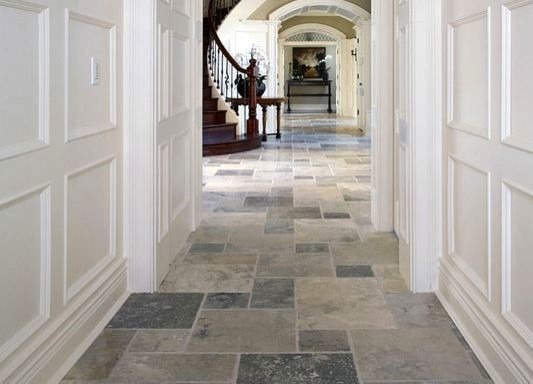
Natural stone tiles have been used consistently for thousands of years. The popularity of natural stone tile floors continues to grow as homeowners realise that natural stone fits in seamlessly with almost any decor system – from contemporary to traditional. Regardless of the type of natural stone tile you choose, all are susceptible to staining and surface wear in varying degrees. To ensure the natural stone provides a lifetime of beauty and function, proper stone care maintenance is recommended.
Take at look at our easyDIY Home Improvement board for more natural stone tile ideas for your home.

Perfect for residential use, both indoors and outdoors, when selecting natural stone tiles for your home it is important to note that there are different types of stone tiles and each needs to be treated according to the suppliers recommendations.


- Granite
As one of the more expensive natural stone alternatives, granite lends an air of elegance and sophistication to interiors. Granite contains a high quartz content, adding a touch of sparkle to a spectrum of colour options.
Since granite is one of the hardest materials on earth you can understand why granite tiles are popular. As an extremely hard and heavy material, working with granite tiles as a do-it-yourself project can be difficult. Specialist cutting equipment needs to be bought, or hired, and you will need help if you are working with larger tiles. For this reason it is generally advisable to have granite tiles professionally installed.
While granite tiles can be polished to a high gloss finish, oils can permeate the stone and for this reason granite should be sealed with a high viscosity sealer that protects the stone from stains and general wear and tear, especially in high traffic areas.
GOOD TO KNOW
Any change in colour as a result of oil spills is an indication that sealer needs to be applied.
- Limestone
Similar in composition to marble and travertine, limestone consists of materials such as calcite and aragonite that is available in a range of muted earth tones and textures. Limestone floor tiles complement both modern and traditional styles due to its varied hues, textures and patterns.
It is a popular choice for many homeowners but, while limestone is heavy, it is a relatively soft natural stone that is susceptible to scratching if not regularly cleaned and sealed. Limestone, like marble and travertine, can easily be stained by acids such as coffee, wine, etc., and should only be cleaned with a neutral or mild cleaner.
- Marble
The smooth finish of marble with its unique vein pattern makes this natural stone tile appealing for home interiors. However, marble is not as hard as granite and is a fairly porous natural stone that is vulnerable to stains. Marble is available in a wide range of colours from purest white to darkest black, all featuring the distinctive vein pattern that runs through the tiles.
While ideal for installation on walls, particular attention needs to be given to proper sealing and ongoing protection when installed as floor tiles. Only use a high viscosity sealer on marble floor tiles, and follow the manufacturer’s guidelines for initial application and maintenance.
Stained marble can be restored using a polishing method that removes the top layer of stone, but this is an expensive procedure. To prevent staining any spills should be immediately blotted up – not wiped – as they occur.

- Sandstone
As the name implies, sandstone is formed from grains of sand under tremendous heat and pressure. Once cut, sandstone tiles offer a smooth finish with a consistent colour in warm earth tones that make it ideal for all décor styles.
As with all natural stone tiles, sandstone needs to be sealed immediately after installation. Care should be taken to immediately blot away any spills to prevent staining, even after sealing.


- Slate
Probably one of the most popular natural stone tile option due to its affordability compared to other natural stone types and its wide range of colours, slate tiles are available in varying tiles sizes and thicknesses, making it the perfect choice for do-it-yourself installation.
Slate stone tiles offer the homeowner a choice of colour options through red, brown and orange – or autumn hues – that blend perfectly with almost any décor style, to dark grey colours that complement modern home interiors. Because of the variation in colours, when selecting a particular slate tile for do-it-yourself installation make sure that the supplier stocks sufficient tiles to complete the job.
Slate tiles can be sealed with a matt sealer for cottage or rustic interiors, or finished to a high sheen for a modern home. It is important to seal slate tiles after installation to not only protect the tile from damage but also to enhance the colour. If left unsealed the flaky nature of this type is susceptible to breaking off, leaving a rough surface that can further strip away.

- Travertine
Travertine is distinguished by the small pores in the surface of the stone that can be polished for a smoother finish or tumbled and brushed for those that prefer a more rustic finish. Generally light in colour, travertine natural stone tiles are available in warm, muted shades of cream, taupe, peach tones as well as pale yellow and red hues.
Travertine stone tiles can be used indoors and outdoors and are popular for patio and entertainment areas and pool surrounds. The colour spectrum allows these tiles to match any style of décor from traditional to uber-chic.
Travertine is a sedimentary limestone consisting mainly of calcite, which means that acid spills, or products with a high alkaline content, can damage the structure of the tile. It is essential that only neutral pH or mild cleaner be used on travertine floor tiles.


